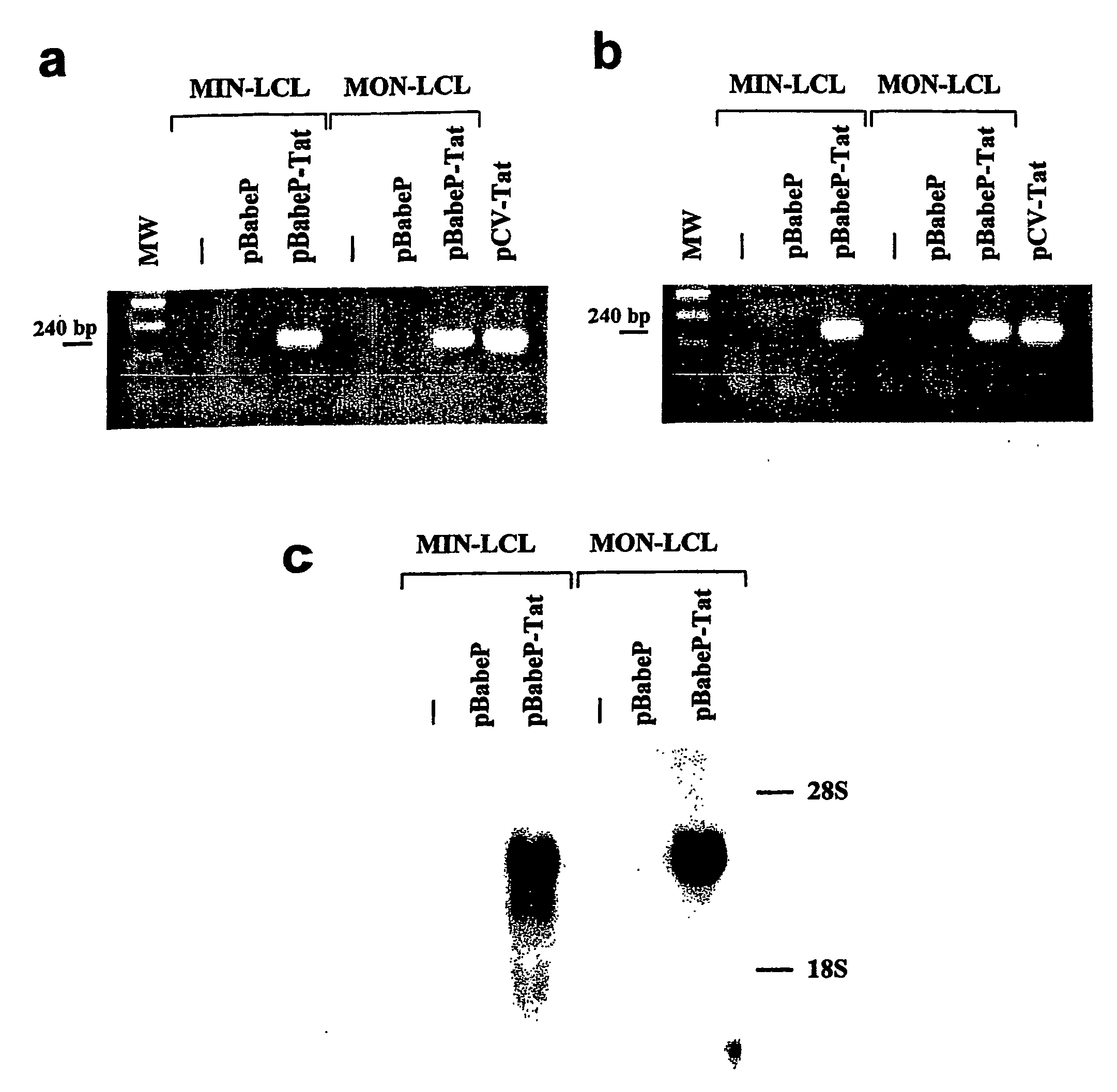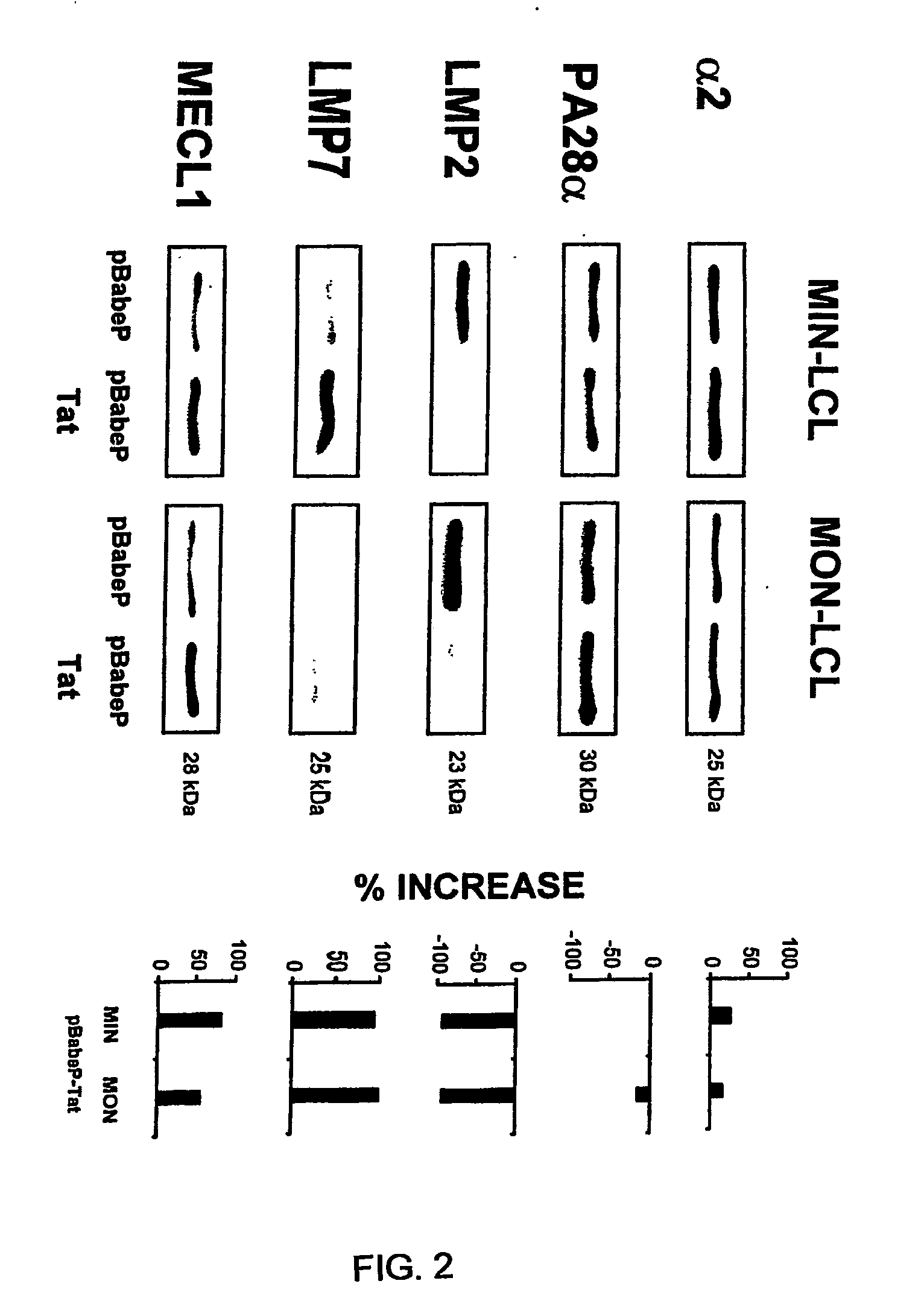Vaccines containing the hiv tat protein as an adjuvant for the enhancement of cytotoxic t-cell responses
- Summary
- Abstract
- Description
- Claims
- Application Information
AI Technical Summary
Benefits of technology
Problems solved by technology
Method used
Image
Examples
example 1
[0153]The following methods were used in this and the following Examples.
Cells
[0154]PG13 murine amphotropic packaging cell line54 was cultured in DMEM supplemented with 10% FCS. Jurkat T cell transfectants (pRPneo-c and pRPneo-c-Tat)22 were cultured in RPMI 1640 medium, supplemented with 10% FCS and 800 μg / ml neomycin (Sigma). Lymphoblastoid cell lines (LCL) were established by in vitro infection of normal B-lymphocytes from healthy donors with the B95.8 strain of EBV. LCL's were cultured in RPMI 1640 medium supplemented with 10% FCS.
Plasmids
[0155]HIV-1 Tat cDNA sequence was amplified by PCR from pGEM-3-Tat plasmid22 using primers Tat A: 5′-GGGGAATTCATGGAGCCAGTAGAT-3′ (forward) (SEQ ID NO 271) and Tat B: 5′-CAAGAATTCCTATTCCTTCGGGCC-3′ (reverse) (SEQ ID NO 272) (annealing temperature 57° C.). The purified PCR product was sequenced and cloned into the EcoRI site of pBabePuro vector to generate pBabePuro-Tat55.
Packaging Cell Lines
[0156]The pBabePuro and pBabePuro-Tat vectors were trans...
example 2
REFERENCES FOR EXAMPLE 2
[0262]1. Caputo, A., J. G. Sodroski, and W. A. Haseltine. 1990. Constitutive expression of HIV-1 tat protein in human Jurkat T cells using a BK virus vector. Journal of Acquired Immune Deficiency Syndrome 3:372.[0263]2. Fanales-Belasio, E., S. Moretti, F. Nappi, G. Barillari, F. Micheletti, A. Cafaro, and B. Ensoli. 2002. Native HIV-1 Tat protein is selectively taken up by monocyte-derived dendritic cells and induces their maturation, Th-1 cytokine production and antigen presenting function. J. Immunol. 168:197.[0264]3. Ensoli, B., L. Buonaguro, G. Barillari, V. Fiorelli, R. Gendelman, R. A. Morgan, P. Wingfield, and R. C. Gallo. 1993. Release, uptake, and effect of extracellular human immunodeficiency virus type 1 Tat protein on cell growth and viral transactivation. J. Virol. 67:277.[0265]4. Gavioli, R., T. Frisan, S. Vertuani, G. W. Bornkamm, and M. G. Masucci. 2001. c-Myc overexpression activates alternative pathways for intracellular proteolysis in lymph...
example 3
REFERENCES FOR EXAMPLE 3
[0293]1. Wu, Y., and J. W. Marsh. 2003. Gene transcription in HIV infection. Microbes Infect. 5:1023.[0294]2. Fanales-Belasio, E., S. Moretti, F. Nappi, G. Barillari, F. Micheletti, A. Cafaro, and B. Ensoli. 2002. Native HIV-1 Tat protein is selectively taken up by monocyte-derived dendritic cells and induces their maturation, Th-1 cytokine production and antigen presenting function. J. Immunol. 168:197.[0295]3. Gavioli, R., E. Gallerani, C. Fortini, M. Fabris, A. Bottoni, A. Canella, A. Bonaccorsi, M. Marastoni, F. Micheletti, A. Cafaro, P. Rimessi, A. Caputo, and B. Ensoli. 2004. HIV-1 Tat protein modulates cytotoxic T cell epitopes by modifying proteasome composition and enzymatic activity. J. Immunol. 173:3838.[0296]4. Ensoli, B., L. Buonaguro, G. Barillari, V. Fiorelli; R. Gendelman, R. A. Morgan, P. Wingfield, and R. C. Gallo. 1993. Release, uptake, and effect of extracellular human immunodeficiency virus type 1 Tat protein on cell growth and viral tran...
PUM
| Property | Measurement | Unit |
|---|---|---|
| optical densities | aaaaa | aaaaa |
| temperature | aaaaa | aaaaa |
| temperature | aaaaa | aaaaa |
Abstract
Description
Claims
Application Information
 Login to View More
Login to View More - R&D
- Intellectual Property
- Life Sciences
- Materials
- Tech Scout
- Unparalleled Data Quality
- Higher Quality Content
- 60% Fewer Hallucinations
Browse by: Latest US Patents, China's latest patents, Technical Efficacy Thesaurus, Application Domain, Technology Topic, Popular Technical Reports.
© 2025 PatSnap. All rights reserved.Legal|Privacy policy|Modern Slavery Act Transparency Statement|Sitemap|About US| Contact US: help@patsnap.com



